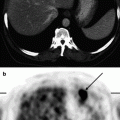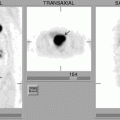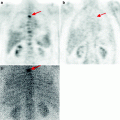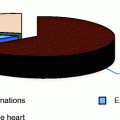, Leonid Tiutin2 and Thomas Schwarz3
(1)
Russian Research Center for Radiology and Surgery, St. Petersburg, Russia
(2)
Department of Radiology and Nuclear Medicine, Russian Research Center for Radiology, St. Petersburg, Russia
(3)
Department of Nuclear Medicine Division of Radiology, Medical University Graz, Graz, Austria
Abstract
Esophageal cancer (EC) is in sixth place in terms of oncological morbidity. In recent years in Russia, a tendency toward a reduction in frequency has been observed. The disease is most often found in elderly men. Before 30 years of age EC is relatively rare. Considerable heterogeneity in geographic distribution of the disease is registered. Particularly high EC morbidity rate is observed in countries of Central Asia, where it exceeds by 10–12 times that in the south-west and west of Russia (Merabishvili 2006).
Esophageal cancer (EC) is in sixth place in terms of oncological morbidity. In recent years in Russia, a tendency toward a reduction in frequency has been observed. The disease is most often found in elderly men. Before 30 years of age EC is relatively rare. Considerable heterogeneity in geographic distribution of the disease is registered. Particularly high EC morbidity rate is observed in countries of Central Asia, where it exceeds by 10–12 times that in the south-west and west of Russia (Merabishvili 2006).
Increase in EC morbidity is influenced by the following factors: regular consumption of hot, coarse and ill-chewed food and alcohol, smoking, chronic inflammatory processes accompanied by cicatrice formation (burn strictures, esophagites accompanying hernia of the esophageal opening, diverticula, reflux-esophagitis, Barret’s esophagus, leukoplakia, sideropenia and benign esophageal polyps (Gantsev 2004).
Among early EC symptoms there are: progressive worsening of the patient’s general condition, lowering of the appetite, growing general weakness, lowering of ability to work, weight loss. Deglutitive disturbanceand dysphagia occur in later stages of development of the tumor process. According to A. Savitsky’s classification, it is accepted to distinguish four grades of dysphagia:
Grade I – aglutition occurring during passage of solid food (bread, meat) through the esophagus
Grade II – aglutition when intaking porridge-like and semi-liquid food
Grade III – aglutition when drinking liquids
Grade IV – complete esophageal obstruction
Pain in the area of the thorax, hoarse voice and sensation of food lump should be also considered as late symptoms of the disease.
6.1 Pathologic Anatomy and Mechanisms of Metastases
The frequency of tumor lesion of different anatomic areas of the esophagus is various. Cancer of the cervical section of the esophagus makes up 10%, that of the thoracic section is 60% and for the esophagogastric section it is 30%.
Three forms of EC are distinguished:
The ulcerous form (saucer-like and crateiform cancers) grows exophytically into the lumen of the esophagus, primarily lengthwise.
The nodal form (fungoid and papillomatous cancers) has the appearance of a cauliflower and obturates the lumen of the esophagus; in necrosis it may look like ulcerous cancer.
The infiltrate form (scirrhous and stenosing cancer) develops in the submucous layer, encircles the esophagus, and manifests itself as a whitish, dense mucous membrane on which ulcerations may occur; in stenosing cancer, circular growth prevails over lengthwise growth.
In 97–99% of cases, EC is planocellular with or without cornification.
The first stage of metastasis in EC occurs primarily in the lymphogenous way. The well-developed lymphatic system in the submucous layer of the organ conditions intramural dissemination of tumor process, sometimes at 4–10 cm from the primary formation.
The second stage of metastasis has its own laws and depends on the situation of the primary formation:
1.
In cancer of the cervical section of the esophagus, prescalene, internal jugular, superior and inferior cervical, periesophageal and supraclavicular lymph nodes are affected.
2.
In cancer of the thoracic section of the esophagus, superior and inferior periesophageal and tracheobronchial lymph nodes are affected.
3.
In cancer of the esophagogastritic section, inferior periesophageal, phrenic, pericardial, celiac lymph nodes as well as those situated along left gastric arteries are affected.
Since the lymphatic vessels of the esophagus flow directly into the thoracic duct, in some cases metastatic lesion of the lymph nodes of the lesser omentum may be observed, as well as that of lymph collectors situated along the left gastric artery, neck and supraclavicular areas. Distant lymphohematogenous metastases of the EC are observed in the liver, lungs and bone system.
6.2 Methods of Diagnosis
Esophagoscopy is an obligatory examination method in EC. A negative result of esophagiscopy is not a sufficient reason to exclude EC diagnosis. A small tumor or ulcer is sometimes difficult to observe, since the extended esophageal wall above the site of lesion may overhang and obturate the pathologic formation. In case of tumor growing infiltratively along the submucous layer, esophagoscopy sometimes detects only the narrowing of the esophagus and hindered passage of the tube. In case of this kind of growth, biopsy results may be negative too.
Tracheobronchoscopy is done in order to diagnose the invasion of esophageal tumor to the bronchus. When invasion symptoms are detected, morphological study is carried out obligatorily.
X-ray permits determination of the form of tumor growth, its localization and extension. The main X-ray signs of EC are: disturbance of landscape structure of the esophageal mucous membrane, filling defect, tumor stain, and absence of peristalsis of the esophageal wall. The earliest and most difficult to detect symptom is absence of peristalsis. In some cases this sign can be the only one and can persist for a long time. Later on, other symptoms manifest themselves: restructuring or destruction of the landscape of the mucous membrane declaring itself by the atypical form and situation of folds, formless deposits of contrast substance or minor areas of clarification.
Stay updated, free articles. Join our Telegram channel

Full access? Get Clinical Tree








